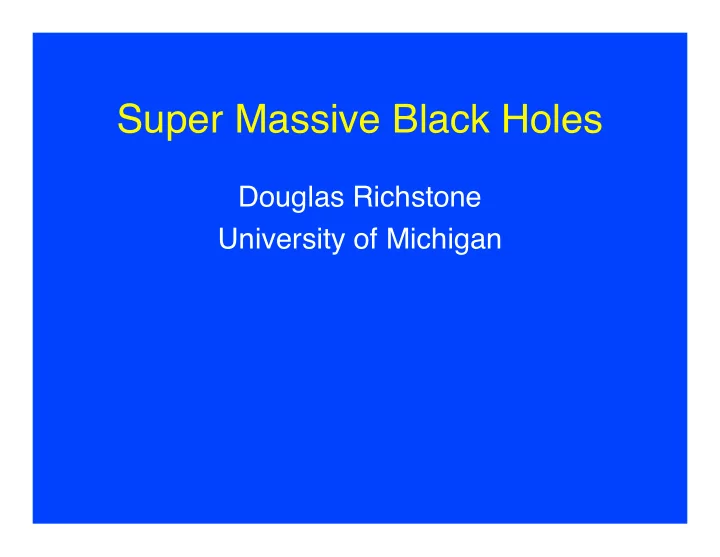

Super Massive Black Holes Douglas Richstone University of Michigan
Thanks to our sponsor
• M. Aller (UM) • T. Lauer (NOAO) • R. Bender (Munich) • J. Kormendy (Texas) • G. Bower (NOAO) • J. Magorrian (C U) • A. Dressler (OCIW) • J. Pinkney (Michigan) • S. Faber (UCSC) • D. Richstone (Mich) • A. Filippenko (UCB) • C. Siopis (Mich) • K. Gebhardt (Texas) • S. Tremaine • R.Green (NOAO) (Princeton) • L. Ho (OCIW)
Summary • Where does the “lore” come from – Quasars, observations of test-mass dynamics, interpretation. • The current demographic picture – M- σ relation, bh mass spectrum, density, comparison to quasars. • Emerging developments – – Slouching toward a theory – The hunt for a “second parameter” – Extension to very low masses
✷ Where does the lore come from? • “It’s idiocy to ignore the details.” - Stanley Kunitz
3c175
Circular and parabolic orbits
Orbit Superposition (Schwarzschild’s method) • Assume a mass distribution. • Compute the gravitational forces. • Follow all the orbits. • Sum the orbits to match the observed velocities. • Failure rules out the mass distribution. • I wish people wouldn’t call this 3 I- it is any I!
� How well does the method work?
✷ The current demographic picture
Results of 15 year effort • Most bulges have BH (97% so far). • BH mass tracks main-body parameters (L, sigma).
• Bulge M/L ~ 3/10_h • Density - 2.5x10^5 Msun/Mpc_ for h=.65 (Yu & Tremaine) - 4.8x10^5h_ Msun/Mpc_ (Aller & Richstone) - consistent results from different datasets. - S = 2.2x10^5 Msun/Mpc 3 - 6 – 9x10^5 (Fabian & Iwasa) qso+X-ray background (and similar from Barger).
� BIG PROBLEM The X-ray background energy exceeds the available sources of energy in known supermassive black holes. (the known population of SBH seems just adequate for the quasar energy).
A note on backgrounds • Any background can be expressed in terms of the cosmic microwave background energy density (about 1eV/cm 3 ). • u qso ~ 10 -4 • ρ bh ~ u qso ε -1 (1 - ε -gw – ejections) • ρ stars ~ 1
Recent developments…
• “Those who forget physics are doomed to repeat it.”
A taxonomy of theories for the M~v 4 relation. • The bh growth is limited by a mass budget (Burkert & Silk). • The bh growth is limited by a momentum budget (Fabian) • BH growth is limited by angular-momentum (AGR). • BH growth limited by energy conservation (Silk & Rees, Blandford). Ciotti & Ostriker, pure core collapse).
Pseudobulges: … rapid rotation V that implies V/ σ values well above the “oblate line” describing rotationally flattened, isotropic spheroids in the V/ σ — ε diagram.
COBE images show that our Galaxy’s bulge is boxy. We conclude that our Galaxy contains a pseudobulge.
“We’re looking forward to looking backward” - Alan Dressler
Grav waves.
Summary • Supermassive black holes are here to stay. • Quasars are OK, may need some very efficient emitters. X-ray background looks tough. • M~v 4 makes theorists salivate and may lead to a model. • Hints of a second parameter.
Recommend
More recommend